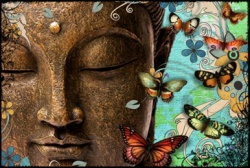Eight Chariots of the Practice Lineage
Tib. sgrub brgyud shing rta brgyad. There are eight lineages of Buddhism in Tibet:
sNa 'gyur rNying ma;
bKa' gdams;
bKa' brgyud;
Zhangs pa bKa' brgyud;
Sa skya;
gCod and
Zhi byed;
dus 'khor/sbyor drug (Kalacakra); and
O rgyan bsnyen grub.
The Dzogchen Ponlop Rinpoche, through Nitartha international, has organized a major new project to support the Tibetan traditions of education and study, the compilation of a compendium of the terminology of the eight major schools of Tibetan Buddhism.
Eminent Tibetan scholars working with Rinpoche will compile explanations of key terms from major reference works of the Eight Traditions.
We believe the Compendium will be a ground-breaking reference work which promises to dramatically increase the understanding of the major traditions of Tibetan Buddhist practice.
Nitartha international was founded by The Dzogchen Ponlop Rinpoche to aid in the support of Tibetan educational systems, and to preserve the precious heritage of Tibet, which is in such great danger of being lost.
Under his leadership, Nitartha international has amassed an extensive digital library of Tibetan texts that can be searched electronically to assist in creating references for the Compendium.
Nitartha has completed over 80,000 pages of text input at its input center in Nepal, and edited several thousand pages of text so far, despite limited manpower and resources.
More than a simple input project, Ponlop Rinpoche has marshaled extraordinary scholarly and technical skills.
Working with software developers to create specialized software and Tibetan scholars to identify and prioritize the most worthy texts for input, key texts have been digitized.
Once in digital form, Nitartha scholars participate in editing the texts for accuracy and in preparing them for modern readers by annotating, footnoting and formatting them.
Technological resources and exceptional scholarship will thus be combined to create The Compendium of Buddhist Terminology.
Using digitized texts and electronic search and data extraction techniques that were previously unavailable to Tibetan scholars, we hope this work will substantially advance the field of Tibetan studies.
Importance of this work
We are at a critical juncture in the preservation of the living educational traditions of the unique Tibetan culture.
The great Tibetan universities are no more; most of the Tibetan teachers who transmitted Tibetan wisdom institutionally and personally are no longer living.
Indeed, the last generation of Tibetans traditionally trained in the great Tibetan universities, or with direct and personal experience and training under the great teachers, are now quite advanced in years.
Once they are no longer with us, we will lose the stored wisdom they hold within their vast experience.
The Tibetan tradition, which continued and developed Indian philosophical and soteriological traditions begun over 2500 years ago, is highly nuanced and complex, and the vocabulary of the written works which embodies those traditions is commensurately difficult to understand outside Tibetan traditions.
Moreover, oral explanations and practical experience are a necessary accompaniment to any living tradition of scholarship and practice.
In Tibet, these oral traditions are even more necessary for understanding Tibetan texts, for each text is interpreted within the context of a living lineage which passes down its critical understanding and applications of the text.
Thus, the Tibetan traditions cannot be preserved merely by reading Tibetan books -- the next generation must be taught how to read and understand the terms found in those books.
The Compendium of Buddhist Terminology will provide analytic explanations and comparisons of the key terms used by the major practice traditions of Tibet.
Though these traditions share similar goals and outward clothes, each tradition provides a discipline and vocabulary specific to the tradition.
The vocabulary used to transmit the wisdom of the tradition has been finely honed over thousands of years by great scholars and practitioners of the tradition.
These terms are used in specific ways, and the traditions cannot be understood without a precise understanding of the nuances of the terms.
The abilities to use computers to digitize the Tibetan corpus and use electronic search and data extraction techniques provides a scholarly resource that was unavailable in classical Tibet.
Thus, we have a unique opportunity to create reference works today that were not available in Tibet.
But these advances will be misdirected if they are not commenced by scholars familiar with traditional Tibetan methods as well as modern resources.
[[Nitartha international[[, through its combination of scholarly and technical resources, it thus in a unique position to make major advances in Tibetan scholarship.
==Eight Major Traditions==
The major practice traditions are often referred to in Tibetan literature as the Eight Chariots of the Practice Lineages of Tibetan Buddhism.
The Eight Chariots refer to the eight major practice lineages of Tibetan learning and attainment, traditions which can be traced directly back through the centuries of the history of Tibet and beyond that into India.
These traditions encompass the major schools and lineages within Tibet:
<poem>
The main doctrinal lineage of Kama, the Ancient Translation School known as Nyingmapa
Atisha's lineage, the Old Kadampa School, and the New Kadampa
The lineage of the glorious Sakyapa
The Four Major Schools and Eight Minor Schools of the lineage of the Marpa Kagyü Tradition
The Shangpa Kagyü
Phadampa Sangye's and Machik Lapdron's lineage
Vajra Yoga Instruction Lineage
The Great Yogi Orgyenpa Rinchenpal's Lineage
Each of the Eight Chariots of the Practice Lineages of Tibetan Buddhism has developed its own individual terminology within the context of specific practices, oral explanations and regional understandings.
An image of Padmasambhava, the originator of many of the oral traditions and written texts used by one of the Eight Chariots, the Nyingma school Similar or identical terms are used differently within the contexts of each tradition's systems, and carry different meanings.
Accordingly, there is enormous confusion among research scholars and translators in explaining and translating terms from different traditions.
There currently exists no encompassing exegesis of the unique meanings and differences between similar terms used in each of the different contexts of the Eight Lineages.
The Compendium of Buddhist Terminology will assist scholars and translators in clearly understanding the distinct meanings of each individual term according to the different traditions without mixing them up.
The original version will be compiled in the Tibetan language.
If there is sufficient interest and funding, we propose to translate the compendium into other languages.
Major support for this project has been provided by the Bodhi Foundation, based in [[Wikipedia:Austin, Texas|Austin, Texas]] and directed by David Lunsford. Nitartha international extends its heartfelt thanks to the Bodhi Foundation for its support. </poem>



